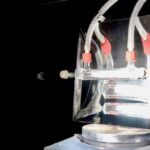Scientists at the University of Geneva (UNIGE) have developed a tool that uses light to precisely control when and where a medicine works, ensuring it works exactly where it is needed. For medical treatments to be effective and to minimize side effects, medicines must work in the right place and at the right time – a challenge that remains elusive.
Now, a team of biologists and chemists at UNIGE has created a system that can activate molecules with brief pulses of light lasting just a few seconds. Tested on a protein essential for cell division, the approach could be applied to other molecules, with promising applications in both research and medicine. It could even improve existing treatments, such as those for skin cancer. The findings were recently published in the journal Nature Communications.
The Challenge of Systemic Medicine Effects
When a medicine enters the body, it not only affects the intended organ, but also spreads systemically, affecting the entire body. This lack of precision can lead to two major risks: the medicine may not effectively reach its target, reducing its intended benefit, or it may cause serious side effects. In Switzerland alone, thousands of people suffer from severe medicine-related side effects every year.
Scientists have now developed a system that allows them to use light to control the activity of molecules in living organisms, thus providing a way to activate medicines only where they are needed.
Breakthrough in Light-controlled Technology
The idea is simple: activate a medicine precisely at its intended location. However, turning this concept into reality is extremely complex. If successful, this approach could allow scientists to activate or inactivate proteins in specific areas of the body, thereby better understanding their functions and improving targeted treatments.
“Everything started with this methodological question,” recalls Monica Gotta, professor at the Department of Cell Physiology and Metabolism of the UNIGE Faculty of Medicine, who initiated and coordinated the study together with Nicolas Winssinger, professor at the Department of Organic Chemistry of the UNIGE Faculty of Medicine. “We were looking for a way to inhibit the protein Plk1, which is involved in cell division, when and where we wanted, to better understand its role in the development of living organisms.”
Breaking the Biological Lock
By combining their expertise in chemistry and biology, the scientists were able to modify the Plk1 inhibitor molecule so that it could be activated by a pulse of light. “After a complex process, we were able to block the active site of our inhibitor with a coumarin derivative, a compound naturally present in certain plants. This coumarin can be removed with a simple pulse of light,” explains Victoria von Glasenapp, a postdoctoral researcher in the labs of Prof. Gotta at the Faculty of Medicine and Prof. Winssinger at the Faculty of Science and first author of the study.
The challenge remained to find a way to anchor the inhibitor at the exact point in the body where its action was needed. “We therefore modified the inhibitor so that it was trapped in the target cell by adding a molecular anchor that is only released by light,” explains Nicolas Winssinger. “This allowed us to activate and anchor the inhibitor with the same light pulse, thereby inactivating Plk1 and stopping cell division at the precise location desired.”
Countless Possible Applications
The system developed by UNIGE scientists makes it possible to control the activity of molecules in living organisms in space and time using light. It can be adapted to many molecules to activate medicines only where they are needed. In the future, a simple laser could activate treatments where they are needed, while leaving the surrounding healthy tissue unaffected, thus limiting undesirable side effects and bringing convenience to the medical industry. “We hope that our tool will be widely used to better understand how organisms function and, in the long run, to develop location-specific therapeutics,” concludes Monica Gotta.











